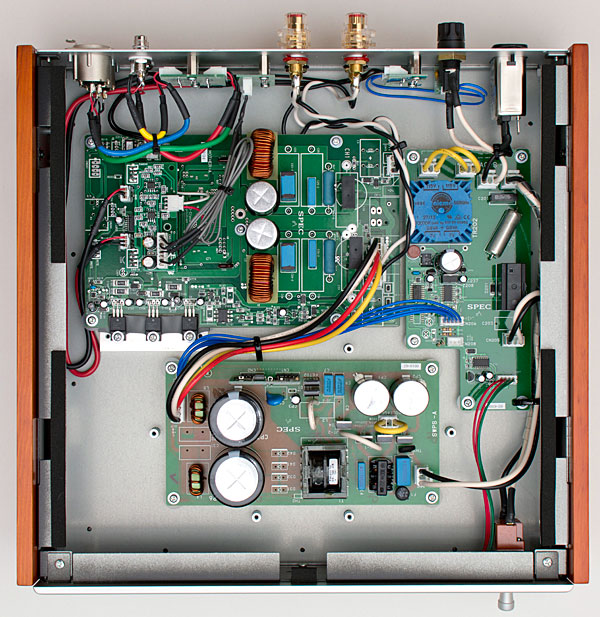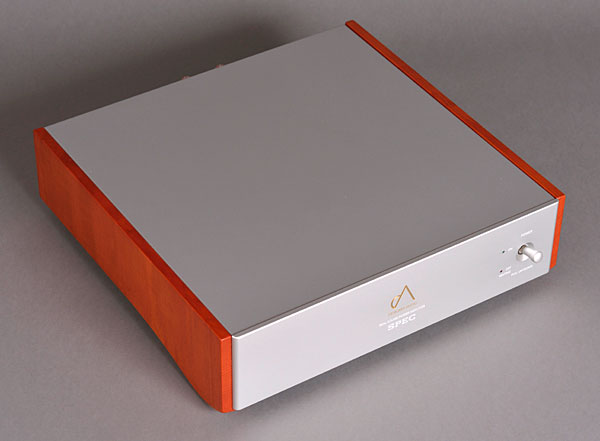| Columns Retired Columns & Blogs |
You said and purchasing, ripping, and selling CDs . I hope you didn't mean that you condone the practice of buying a CD, ripping it then selling it on whilst keeping the rip?
The Spec RPA-W7EX was unforgiving of lesser recordings, but when presented with a well-recorded album, such as Sonny Rollins's soundtrack music for Alfie (LP, Impulse! A-9111), or doomed jazz singer Beverly Kenney's Come Swing with Me (LP, Royal Roost RLP 2212), this modest-looking amplifier was positively surgical in its retrieval of low-level information—yet it achieved the not-so-easy feat of doing so without sounding sterile or clinical. With every LP and digital file I sent its way, the Spec exposed the recording's unique tonal, dynamic, and textural elements with natural spirit and a practically feminine touch.
To answer the nagging question "Can the Spec bass-boogie or not?," I turned to seminal Krautrock terrain: Kraftwerk's 1974 album, Autobahn (LP, Vertigo VEL-2003). Fabled recording engineer Rudy Van Gelder may have been the master of capturing the double-bass sonorities of Paul Chambers, Ron Carter, and Reggie Workman, et al, but for bass reproduction without borders, analog synthesizers reign supreme. The motorik grooves of this album's title track sounded delicate and precise via the Spec, yet lacked that last degree of low-end dread. Yet musically, the track was a full-on rave, its humming, forward momentum and sleek sounds rumbling delightfully by.

I then opted for the contemporary bass-synth warfare of Brandt Brauer Frick's super-percussive Mr. Machine (2 LPs, K7! K7286LP). On this exquisitely recorded album, Frick plies various percussive and melodic instruments in configurations that challenge the categories of electronic, funk, and contemporary classical music. "Mi Corazon" begins with a lone bass drum pulsing 4/4, soon joined by madly pitching timpani, triangle, piano, and squirming synth bass. The Spec portrayed all of this track's graphic qualities, establishing instrumental images with sharply defined leading edges on a vividly present soundstage. Synth-bass notes buzzed under my feet like angry wasps, the Spec resolving the last iota of gasping baritone air, which recalled steam rising from a Manhattan manhole.
Not totally sated, I played a disc that goes even further in conjuring bass'n'rhythm fury from growling synths: Loscil's Sketches from New Brighton (LP, Kranky 171). "Second Narrows" is serene in a ghostly way, like slow-moving sea creatures in a death dance. Highly detailed, grain-free (another consistent Spec quality), and rather slimy, its bass notes dipped down with superior decay and sustain, hovering before me like the summer sun, all heat and glare. The Spec outlined Loscil's unctuous bass blobs with microdynamic precision, but the images lacked ultimate depth and weight. Resolution of this dynamic track was solid, though I didn't feel enveloped in sound. But the spectral soul of "Second Narrows" was convincing, its visceral grip on my ears and brain a thrill.
We were talking jazz, right? There is no greater mid-1960s jazz recording than Hammond B3-slaying organist Larry Young's Unity (mono LP, Blue Note 4221). Young innovated a unique, modal style of organ jazz that has yet to be matched. "Zoltan" highlights Young's scorching technique, accompanied by tenor man Joe Henderson, trumpeter Woody Shaw, and drummer Elvin Jones. The Spec presented Young's glowing Hammond organ pedals with ferocity and power, and, as with every recording I played through it, each instrumental line was easy to follow, regardless of the volume or the complexity of the arrangement. Even given its unparalleled resolution, the Spec's spatial depiction of this mono disc was oddly shrunken. Individual sounds were spatially well defined, with sharp leading edges, but those elements were smaller in scale than I'd heard before in my system.

Results were similar with Workin' with the Miles Davis Quintet (LP, Prestige 7166). The Spec re-created Davis's lyrical trumpet with the sweetest tone and quickest delivery I've ever heard, and did the same for John Coltrane's rangy tenor, Red Garland's effervescent piano, and Philly Joe Jones's drum set. The sound of Philly Joe's ride cymbal had incredible stick definition, good cymbal body, and harmonic overtones—again, all as I'd never heard before from my rig. I realized that the Spec's tonal signature, while largely true to the source, was somewhat dark, lending a burnished feel to brasses, bass, and reeds. Paul Chambers's chugging double bass was warm and clear, but also rather soft and a mite thin.
Moving forward in the last century, Norwegian electric guitarist Terje Rypdal's self-titled 1979 album, with bassist Miroslav Vitous and drummer Jack DeJohnette (LP, ECM 1125), proffers an excellent example of producer Manfred Eicher's atmospheric approach: brilliantly recorded instruments on an expansive soundstage. The Spec purveyed every detail of DeJohnette's hyperactive drumming and Rypdal's sky-strafing guitars. Sustain and decay were superb within a swirling, stormy soundstage. As with the other recordings I'd listened to, the Spec's consistently superb retrieval of upper-register transients was thrilling.
Comparison
My 10-year-old Shindo Haut-Brion didn't match the Spec for ultimate resolution or upper-treble purity, nor did it meet that overachiever's low noise floor and startling microdynamics. But the Shindo reasserted itself with a massive soundstage that extended in all directions and suggested tremendous weight and solidity. I purchased the Haut-Brion to replace a Shindo Montrachet, in part for the former's substantial low end, equally substantial sense of scale, natural-sounding tonality, and sensuous portrayal of instrumental textures. In the first two out of those four traits, the Spec couldn't compete.
Caveat
In evaluating the Spec, I found Music Hall's hirsute Mooo Mat an indispensable accessory for my Kuzma Stabi turntable. When I laid LPs on my usual record mat—Music Hall's Aztec Blue—the Spec's sound could be small, and lack the low-end fundamentals it had with the Mooo atop my Kuzma pipe bomb.

But on the last day I did any listening for this review, I received from Jonathan Halpern of Tone Imports, Spec's US distributor, the Spec AP-UD1 Analog Disc Sheet ($350): a disc of aluminum coated in a "soluble resin." Compared with the Mooo, the Sheet focused the midrange, seemed to lower the noise floor, and increased resolution. The sound became purer, more spacious, and more liquid—definitely more enjoyable. Could this be an easier way to get Spec's Real-Sound? Time will tell.
Conclusion
The Spec RPA-W7EX Real-Sound proved its $5995 worth as a benevolent truth teller, consistently wowing me with how well it wrested the last bit of information from every LP I played. Its first-rate resolution and seemingly nonexistent noise floor made possible many late nights of discovering new sounds from old LPs.
Everyone I've invited to my penthouse pad to hear the RPA-W7EX has been enchanted by its superbly detailed reproduction of music: never clinical or mechanical, yet consistently natural. The Spec's sound flowed. Its fast release of notes, and subtle but powerful tonal and rhythmic abilities, revitalized my LP collection. Regardless of the volume level or the recording's inherent dynamics, the Spec's remarkable resolution, first-rate imaging, and spot-on tonal colors remained constant, and the amplifier was never flustered by wide dynamic range or steep power demands. And while the Spec's bass weight, soundstage, and general warmth fell far short of my reference Shindo Haut-Brion, those MIA qualities were evident only in direct comparisons, not when I listened to the Spec on its own. Playing jazz, boogie-woogie, or electronic gumbo, the Spec provided the kind of natural bass frequencies any music lover could hope for.
The Spec RPA-W7EX expresses the colorful soul and vivid textures of a tubed amplifier with the unfaltering resolution, vanishingly low noise floor, and power of the best class-D switching amplifiers. In my opinion, class-D amplification still has a way to go before it can unseat the best tubed and class-A amps from their royal positions as kings of the high-end hill. But while $5995 isn't cheap, Spec's RPA-W7EX Real-Sound has made a big crack in the kings' imperial fortress.

I think this discussion about ripping a CD and what you can or cannot do with is so over.

The test data for this amp look like something out of the deep dark hacker past! I got a little Topping for use with the computer (and some mid-sized old Altec bookshelf speakers) that sounds wonderful including clear, tight bass. For less than $100. Main complaint is lack of power - OK for the computer, but I wouldn't want to try driving anything much bigger or in a bigger room.

the measurements are rubbish for this amp. a $300 Yamaha amp will trounce this cat.

looking at the board design this amp was clearly designed by linear amp designer
"If you see toroids in the output filter, shudder. If it's mounted upright, shudder once more." Bruno Putzeys
Its like they read this article on what not to do and then do That.
http://www.audioholics.com/audio-amplifier/switching-amplifier-class-d-basics/switching-amplifier-class-d-basics-page-2
Everything from transistor positions, ground board design, connector positions, filter components it is Bad i dont think this amp will pass CE FCC.

"If you see toroids in the output filter, shudder. If it's mounted upright, shudder once more."—Bruno Putzeys
When Bruno speaks, wise men listen!
John Atkinson
Editor, Stereophile